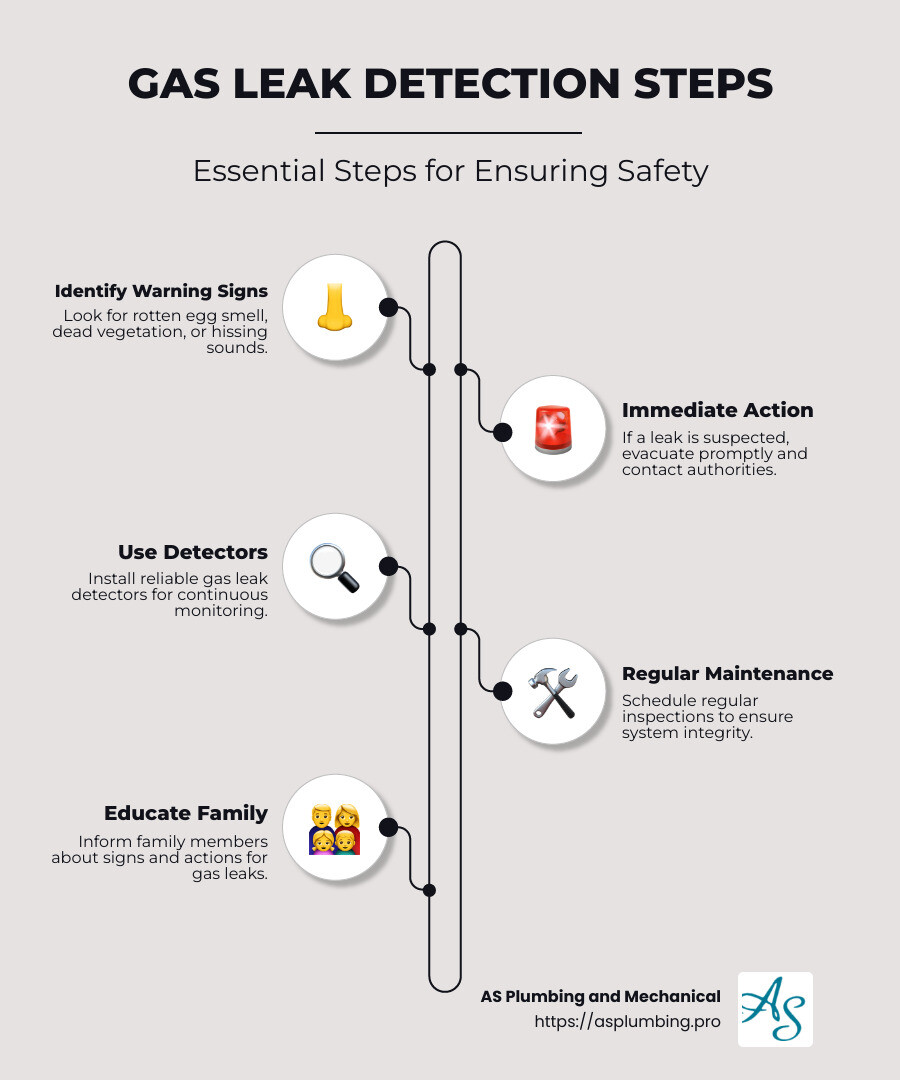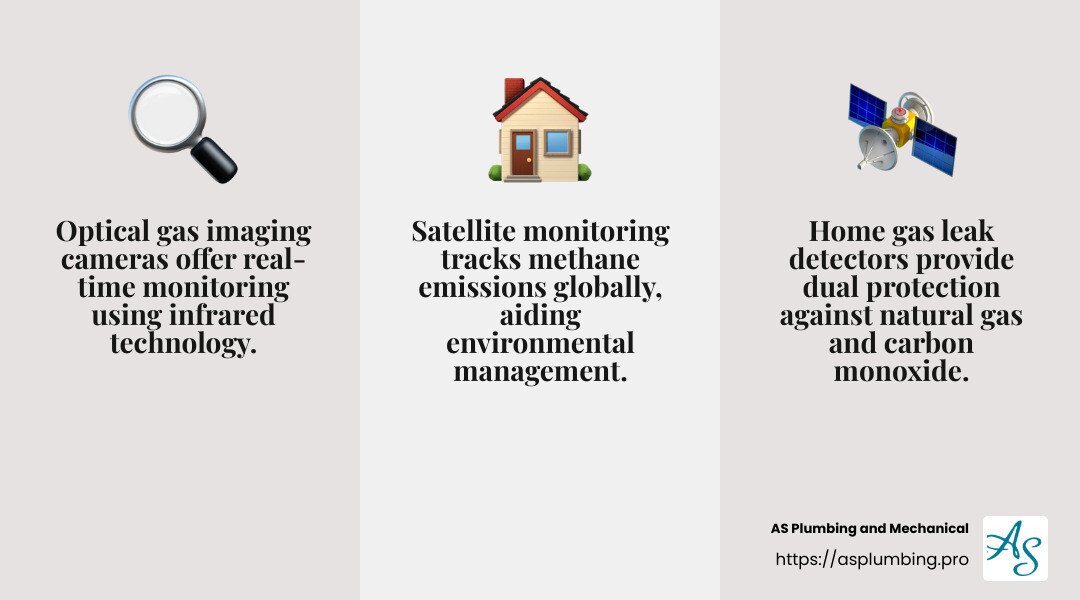Gas Leak Detection: Top 3 Essential Tools 2025
Gas leak detection is crucial to maintaining a safe and secure home environment. As homeowners in areas like Upland or Riverside, CA, being aware of potential gas leaks can not only prevent dangerous situations but also ensure that your family and property are protected. Here’s a quick overview for anyone looking to quickly understand gas leak detection:
- Early Warning Signs: Look for a rotten egg smell, dead vegetation, or hissing sounds near appliances.
- Immediate Action: If you suspect a leak, leave immediately and contact authorities.
- Regular Inspections: Invest in gas leak detectors and schedule regular inspections.
Gas leaks can result in fires or explosions and pose significant health risks. That’s why knowing how to detect them is vital. Whether it’s the distinctive sulfur-like odor or the sight of wilting plants, recognizing the signs can make all the difference.
For homeowners, especially in our local Californian communities, taking proactive steps, like installing reliable detection equipment and scheduling regular maintenance checks, can make all the difference in preventing harm.

Basic gas leak detection terms:
– best leak detection company
– how to detect a gas leak
– plumbing leak detection near me
Understanding Gas Leaks
Natural gas is a common energy source in many homes, but it comes with certain risks if not handled properly. Understanding the nature of natural gas and how to detect leaks can help keep your home safe.
What is Natural Gas?
Natural gas, primarily composed of methane, is a colorless and odorless gas. Because it’s naturally undetectable by smell, a distinctive sulfur or “rotten egg” odor is added to help identify leaks. This smell is due to a chemical called mercaptan, which acts as a warning sign for homeowners.
Signs of a Gas Leak
Detecting a gas leak early can prevent dangerous situations. Here are some common signs to look out for:
-
Distinct Smell: As mentioned, the sulfur-like odor is the most noticeable indicator of a gas leak.
-
Visual Signs: Look for dead or dying vegetation in areas where plants should be thriving. This could indicate a leak in underground pipes.
-
Hissing Sound: If you hear a hissing or roaring sound near gas appliances, it could be a sign of a gas leak.
-
Bubbles: If you notice bubbles forming in pools of water or puddles, it might be due to a gas leak beneath the surface.

Importance of Detection
Gas leak detection is essential to ensure the safety of your household. Quick detection not only prevents potential fires or explosions but also protects against health risks from prolonged exposure. Installing gas detectors and keeping an eye out for these signs can help safeguard your home.
In our Californian communities, such as Claremont or Riverside, being vigilant about gas leaks is crucial due to the widespread use of natural gas in homes. By understanding the signs and taking action when necessary, you can help keep your family and property safe.
Top Gas Leak Detection Equipment
Detecting gas leaks quickly and accurately is crucial for safety. Here’s a look at some of the top equipment used for gas leak detection.
Optical Gas Imaging Cameras
Optical gas imaging cameras are a leading tool in methane detection. These cameras provide real-time monitoring, allowing technicians to visualize gas leaks that are invisible to the naked eye. Using infrared technology, they can identify even the smallest leaks from a safe distance. This technology is particularly useful in industrial settings where pinpointing leaks quickly can prevent significant hazards.
Home Gas Leak Detectors
For homeowners, installing a home gas leak detector is an effective way to ensure safety. Plug-in models are popular due to their easy installation and portability. Many modern detectors, such as the USI Natural Gas Alarms, offer dual protection against natural gas and carbon monoxide. These units often feature a digital display that shows the concentration levels of detected gases, providing peace of mind through clear and direct information.

Satellite Monitoring
On a larger scale, satellite monitoring offers a groundbreaking approach to tracking methane emissions globally. Initiatives like MethaneSAT enable comprehensive global emissions tracking, providing valuable data for environmental monitoring. While satellites are not typically used for individual home detection, they play a vital role in understanding and managing emissions on a broader scale. This technology helps governments and organizations identify problematic areas and develop strategies to reduce emissions worldwide.
By utilizing these advanced technologies, from home detectors to satellite systems, we can better manage and mitigate the risks associated with gas leaks. Whether you’re a homeowner or part of an industrial operation, these tools provide essential support in maintaining a safe environment.
How to Detect a Gas Leak
Detecting a gas leak early can prevent dangerous situations. Here are some simple ways to identify a gas leak in your home or business.
Distinct Smell
Natural gas is naturally odorless, but for safety, a sulfur-like “rotten egg” smell is added. If you notice this distinct odor, it may indicate a gas leak. It’s important to familiarize yourself with this smell, as it is the first line of defense in detecting leaks.
Visual Signs
Look for visual cues that might suggest a gas leak. These can include:
- Bubbles in Water: If you see bubbles forming in puddles or wet areas, it could mean gas is escaping.
- Dust or Dirt Blowing: Gas leaks can cause dust or dirt to blow up from the ground.
- Dead Vegetation: Patches of dead or dying plants in an otherwise healthy area can indicate a leak underground.
Hissing Sound
Listen for unusual sounds near gas appliances or lines. A hissing or roaring sound can indicate a gas leak, especially if it’s coming from a pipe or gas connection. This sound may vary depending on the size of the leak.
Bubbles Test
If you suspect a small leak around a connection or joint, you can perform a simple bubbles test. Mix a small amount of dish soap with water and apply it to the area. If bubbles form, it indicates gas is escaping.
By using these methods to detect gas leaks, you can take action quickly and ensure the safety of your home or business. If you suspect a leak, always evacuate the area and call professionals for help immediately.
Frequently Asked Questions about Gas Leak Detection
How do you detect a gas leak?
Detecting a gas leak involves using your senses and some simple tests. Start by smelling for the distinct sulfur-like odor that is added to natural gas. If you notice this “rotten egg” smell, it could be a sign of a leak.
Next, look for visual signs such as bubbles in standing water, dust or dirt blowing in the air, or patches of dead vegetation in your yard, which might indicate a leak underground.
Finally, listen for a hissing sound near gas appliances or pipes. This sound can suggest a gas leak, especially if it is continuous.
Is there a device that can detect gas leaks?
Yes, there are devices specifically designed for gas leak detection. Homeowners can use plug-in gas detectors, like the USI Natural Gas Alarms, which provide a digital display and alert you to the presence of natural gas. These detectors are easy to use and can be installed in rooms with gas appliances to offer continuous monitoring.
For more advanced detection, there are optical gas imaging cameras and even satellite technologies like MethaneSAT that track global emissions, but these are typically used by professionals.
How much does it cost for a gas leak test?
The cost of a gas leak test can vary depending on several factors, such as the complexity of the leak and the method used. A pressure test, which is a common method to check for leaks in a gas line, might cost between $100 and $500. However, prices can vary based on location and the specific services provided. It’s always best to consult with a professional to get an accurate estimate for your situation.
Conclusion
At AS Plumbing and Mechanical, we understand the importance of keeping your home safe from gas leaks. Our commitment to customer satisfaction drives us to provide top-notch service with honest pricing and clear communication. We offer advanced leak detection services that ensure your home is safe and secure.
With our 24/7 emergency services, you can count on us to be there when you need us most. Our expert technicians use state-of-the-art equipment to detect and repair gas leaks quickly and efficiently. Whether it’s using home gas leak detectors or employing more advanced technologies, we tailor our approach to meet your needs.
Our family-owned business is proud to serve communities across Southern California, including Upland, Riverside, and surrounding areas. We stand by our work with a one-year labor warranty, giving you peace of mind and confidence in our services.
Don’t wait until it’s too late. If you suspect a gas leak, contact us immediately for fast and reliable solutions. Trust AS Plumbing and Mechanical to keep your home safe from the dangers of gas leaks.
